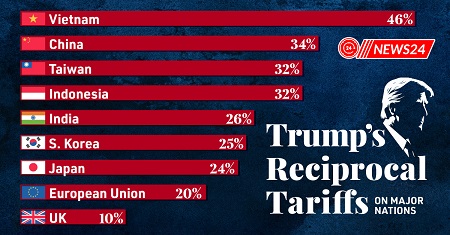Introductory part
Under President Donald Trump’s administration, the return of hostile trade policies has flamed world economic disquiet. Sweeping tariffs have also thrown international supply chains and markets into disarray and put a strain on diplomatic ties. The many ways these tariffs affect worldwide trade dynamics are investigated in this thorough study.

The beginning of the escalation of rates
Tariffs on Liberation Day.
President Trump declared a national emergency on April 2, 2025 to tackle the United States’ trade deficit and imposed a 10% basic tariff on all imports effective April 5. Furthermore, specific to countries reciprocal tariffs were declared intended to hit nations with substantial trade surpluses opposed to the United States. These steps indicated a major move toward protectionist commerce policies.
Scope and Application
Covering many different nations, the tariffs impacted a large group of products. China notably encountered an effective export tariff of 54% towards the U.S., which rose to 104% after other measures. Other nations, among them India, South Korea, and Japan, were charged between 24% and 29 percent.
The countermeasures of China
Counter the US’ actions. tariffs, China imposed its own set of retaliatory tariffs, reaching up to 125% on American goods. Essential for many advanced sectors, the Chinese government also put a stop to exports of critical rare-earth elements. With China stressing its will to suffer financial difficulties, these behaviors indicated a hard line.
Impact on worldwide economies
volatility of stock market
Tariffs caused major volatility in world stock markets. Uncertainty put off investors’ responses, so major indexes dropped significantly. The volatility pointed to the interdependence of world economies and the extensive effects of trade conflicts.
Supply chain interruptions
The duties upset reliable logistics, so businesses had to look for different manufacturing and sourcing processes. American companies had to contend with rising expenses and logistical issues even as their Chinese counterparts looked into markets beyond the U.S. in view of stalled shipments.
Consequences on Key United States Actors in commerce
Canada and Mexico.
The United States received a reaction from Canada. tariffs with its own set of duties, imposing 25% tariffs on a broad spectrum of American goods. Initially contemplating similar policies, Mexico made a provisional arrangement with the United States. to put back the operating of retaliation tariffs.
United Kingdom is here.
The United Kingdom is classified sensitive trade materials as “secret” to protect their negotiating power. British officials showing worry about the possible effects of the Russian invasion on critical sectors such as steel and automotive as well as refraining from instant retaliation.
India.
India’s economy showed resilience in the face of the worldwide trade chaos. Confident domestic investors protected the market against outflows of foreign capital. Still, worldwide electronics companies balked at fresh e-waste laws, underlining the difficulties of striking a balance between economic interests and environmental policies.
Strategic Movements and Long-range Results
Expansion of Commercial Partners
Nations perturbed by the U.S.mediation tariffs are actively seeking to diversify their trade partnerships. China’s outreach to Southeast Asian countries and initiatives to strengthen its high technology sector illustrate this tactical change. Other countries are also looking into regional trade agreements as way of reducing American influence. Protectionism.
Reconsideration of Policies on World Trade
The present trade tension have spurred a revisiting of international trade policy. Countries are rethinking their dependency on single markets and stressing the need of economic self-reliance and diversification. This change could result in a more multipolar trade scene over the next few years.
Final statements
The Trump government’s aggressive trade policies have set off a complicated web of economic responses everywhere. Though meant to tackle trade imbalances, these policies have caused market uncertainty, countermeasures, and a rethinking of international trade approaches. The long-term effects will help to define the future of global trade as countries adjust to this fresh reality.
Learn more about Rajkot update news
